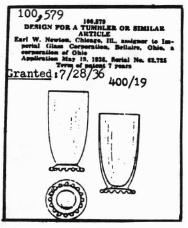National Depression Glass Association
Preserving America's Glass Manufacturing Heritage
Candlewick Patents
by Virginia Scott
Glass Review - September 1985
 In 1977 I made my first visit to Imperial Glass Corporation in
Bellaire, OH to research Candlewick. While there I examined nine
Candlewick catalogs and several notebook binders or "scrapbooks". On
the first page of one binder which was labeled "Exclusively Candlewick"
was a table which listed the Candlewick patents. This table, shown in
No. 2, gives the patent number, patent date, mold
number and Candlewick Item patented.
In 1977 I made my first visit to Imperial Glass Corporation in
Bellaire, OH to research Candlewick. While there I examined nine
Candlewick catalogs and several notebook binders or "scrapbooks". On
the first page of one binder which was labeled "Exclusively Candlewick"
was a table which listed the Candlewick patents. This table, shown in
No. 2, gives the patent number, patent date, mold
number and Candlewick Item patented.
[NOTE: all references, such as "No. 2" refer to the illustration at the end of this article.]
 Candlewick was first patented in 1936 with patents granted for a
4-toed bowl (at left), plates (below, right) and 400/19 tumblers
(above, right). The earliest Candlewick catalog, about 1936, shows
the 400/74B 4-toed bowl and plates in several sizes and styles, but the
400/19 tumblers were not introduced until about 1941.
Candlewick was first patented in 1936 with patents granted for a
4-toed bowl (at left), plates (below, right) and 400/19 tumblers
(above, right). The earliest Candlewick catalog, about 1936, shows
the 400/74B 4-toed bowl and plates in several sizes and styles, but the
400/19 tumblers were not introduced until about 1941.
For some time Candlewick researchers were puzzled by the item listed in the table as a "Lighting Bowl". When the patent designs were found in the patent books in 1984 the "lighting bowl" turned out to be the globe for a ceiling fixture (No. 1). Collectors had reported finding large and small globes which resembled candlewick. Finally a small globe was found which had a label with the 104,222 Patent number, authenticating it as Candlewick.
The 1936 and 1937 patent designs were assigned to Imperial by Earl
W. Newton, president of Imperial in the 1930's after the company was
reorganized following bankruptcy. Mr. Newton is said to have conceived
 the idea of Candlewick pattern after he purchased a piece of an old
French "cannonball" pattern.
the idea of Candlewick pattern after he purchased a piece of an old
French "cannonball" pattern.
In the early 1940's, (Carl W. Gustkey became president of Imperial. Two items on the patent list, the tall compote, No. 3 and the twin candleholder, No.4, were signed by him. The remaining items were assigned by Carl J. Uhrmann who came to Imperial as an employee in 1936, became plant superintendent in the 1940s and was president from 1957 to 1964. Mr. Uhrmann was credited with much of the development of Candlewick and the highest number of Candlewick items were offered during his tenure.
It is interesting to note that each of the patent designs earned a notation that it was for the item shown or for "a similar item substantially as shown". This allows for production of similar items under the same patent. For example, the tall compote. No. 3, has beads in the stem. It is assumed that the beaded-Stem Candlewick stemware was covered by this patent, as no patent has been located for any stemware. The heart-shaped center handle used on several Candlewick trays, including the deviled egg tray, is shown in No. 5.
The "question mark" handle shown on the cup design, No. 6, was also used on Candlewick sugars, creamers, cream soups and bouillon cups. Probably the most innovative use of that handle was as a stand on the back of a 4½" round boudoir mirror made for I. Rice Co. in the early 1940's.
Adapters to be used in candleholders are shown in No. 8 and 9. I have included the Eagle adapter, No. 9, although it does not appear on the Candlewick patent list and is not actually Candlewick. This adapter was shown in various Candlewick candleholders in catalogs and pictures and so has been "adopted" into the pattern by collectors.
A January, 1943 Candlewick Price List states that Imperial Candlewick is a patented design and gives a list of the patent numbers listed in the table, .No. 2, as the patent numbers that apply. "Applications are pending on others" is added. So, there may be other patents for Candlewick. If so, they have not yet been found in the U.S. Patent Office publications.
 |